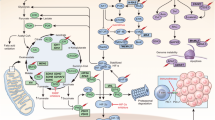Abstract
Background
Malignant pheochromocytomas are rare tumors comprising about 15% of all pheochromocytomas. A specific diagnosis of malignancy requires evidence of local invasion or metastases. The purpose of this paper is to review current management of pheochromocytomas proven to be malignant.
Methods
Both a review of the literature and case studies of more than 100 patients with proven malignant pheochromocytoma seen at the University of Michigan Hospitals from 1980 to 1992 are the basis of management recommendations. Representative individual cases are used to illustrate treatment principles.
Results
Malignancy as evidence by local invasion, particularly peritumor veins, does not preclude complete resection. Bone is the most common site of distant metastases. The131I-MIBG scintiscan is the most useful means of identifying occult metastases.
Conclusions
Aggressive surgical resection of local recurrences and soft tissue metastases can result in excellent palliation. Adrenergic blockade is a cornerstone of treatment, regardless whether surgical resection, triple drug therapy,131I-MIBG or external radiation therapy is ultimately utilized.
Zusammenfassung
Grundlagen
Maligne Phäochromozytome sind seltene Tumoren. Rund 15% aller Phäochromozytome sind bösartig. Lokal invasives Wachstum oder Metastasen sind Hinweise auf Malignität. In vorliegender Übersicht soll das zur Zeit gängige Vorgehen bei malignen Phäochromozytomen dargestellt werden.
Methodik
Anhand einer Literaturübersicht und anhand von Kasuistiken der Jahre 1980 bis 1992, ausgewähtl aus mehr als 100 Patienten mit nachgewiesenen, an der Universität von Michigan behandelten, malignen Phäochromozytomen, werden Therapieeempfehlungen abgeleitet. Besonders eindrucksvolle Krankheitsverläufe wurden zur besonderen Darstellung der Behandlungsprinzipien herangezogen.
Ergebnisse
Malignität, gekennzeichnet durch lokales, invasives Wachstum besonders in große Venen, schließt radikale Resektionen nicht aus. Fernmetastasen sind vorwiegend in Knochen lokalisiert. Okkulte Metastasen können mit dem131J-MIBG-Scan nachgewiesen werden.
Schlußfolgerungen
Eine aggressive, chirurgische Resektion von Lokalrezidiven und Weichteilmetastasen bewirkt eine optimale Palliation. Eine adrenerge Blockade ist die Grundlage für jede Therapie, egal ob chirurgisch, medikamentös, mit131J-MIBG oder durch externe Strahlentherapie.
Similar content being viewed by others
References
Averbuck SD, Steakly CS, Young RC et al: Effective treatment with a combination of cyclophosphamide, vincristine and clacarbazine. Ann Int Med 1988;109:267.
Carney JA, Sizemore GW, Sheps SG: Adrenal medullary disease in multiple endocrine neoplasia, type 2: Pheochromocytoma and its precursors. Am J Clin Pathol 1976;66:279.
Helman LJ, Cohen PS, Averbuck SD, et al: Neuropeptide Y expression distinguishes malignant from benign pheochromocytoma. J Clin Oncol 1989:7:21.
Hosaka Y, Rainwater LM, Grant CS, et al: Pheochromocytoma nuclear, deoxyribonucleic acid pattern studied by fluorocytometry. Surgery 1986;100:1003.
Linnoila RI, Lack EE, Steinberg SM, Keiser HR: Decreased expression of neuropeptides in malignant paraganglioma. An immunohistochemical study. Hum Pathol 1988;19:41.
Lynn MD, Braunstein EM, Wahl RL, et al: Bone metastases in pheochromocytoma: Comparative studies of efficacy of imaging. Radiology 1986;160:701.
McDougall IR: Malignant pheochromocytoma treated by131I-MIBG. J Nucl Med 1984;25:249–250.
Melicow MM: One hundred cases of pheochromocytoma (107) tumors at the Colombia-Presbyterian Medical Center 1926-76: A clinicopathologic analysis. Cancer 1977;40:1987.
Proye C, Fossati P, Fontaine, P: Dopamine-secreting pheochromocytoma: an unrecognized entity? Classification of pheochromocytoma according to their type of secretion. Surgery 1986; 100: 1154.
Scott HW, Halter SA: Oncological aspects of pheochromocytoma: The importance of follow-up. Surgery 1984;96: 1061.
Scott HW Jr, Reynolds V, Green N, et al: Clinical experience with malignant pheochromocytomas. Surg Gyn Obstet 1982; 154: 801.
Shapiro B, Fig L: Management of pheochromocytoma. Endocrinol Metab Clin North Am 1988; 18: 443–481.
Shapiro B, Sisson JC, Hyod R, et al: Malignant pheochromocytoma: Clinical biochemical and scintigraphic characterization. Clin Endocrinol 1984; 20: 189–203.
Thompson NW, Allo MD: Surgery of the adrenal glands, in Schwartz SI, Ellis H (eds): Maingot's abdominal operations. 8th ed. Norwalk/CT, Appelton Century Crofts, 1985, pp 505–529.
Thompson NW, Allo MD, Shapiro B, et al: Extraadrenal and metastatic pheochromocytoma: The role of 131 I MIBG in localization and management. World J of Surgery 1984; 8: 605–611.
van Heerden JA, Roland CF, Carney A, et al: Long-term evaluation following resection of apparently benign pheochromocytomas (Paragangliomas). World J Surg 1990; 14: 325.
Wheeler MH, Chare MJB, Austin TR, Lazarus JH: The management of the patient with catecholamine excess. World J Surg 1982; 6: 735–747.
Author information
Authors and Affiliations
Rights and permissions
About this article
Cite this article
Thompson, N.W. Malignant pheochromocytoma. Acta Chir Austriaca 25, 235–239 (1993). https://doi.org/10.1007/BF02602112
Issue Date:
DOI: https://doi.org/10.1007/BF02602112




